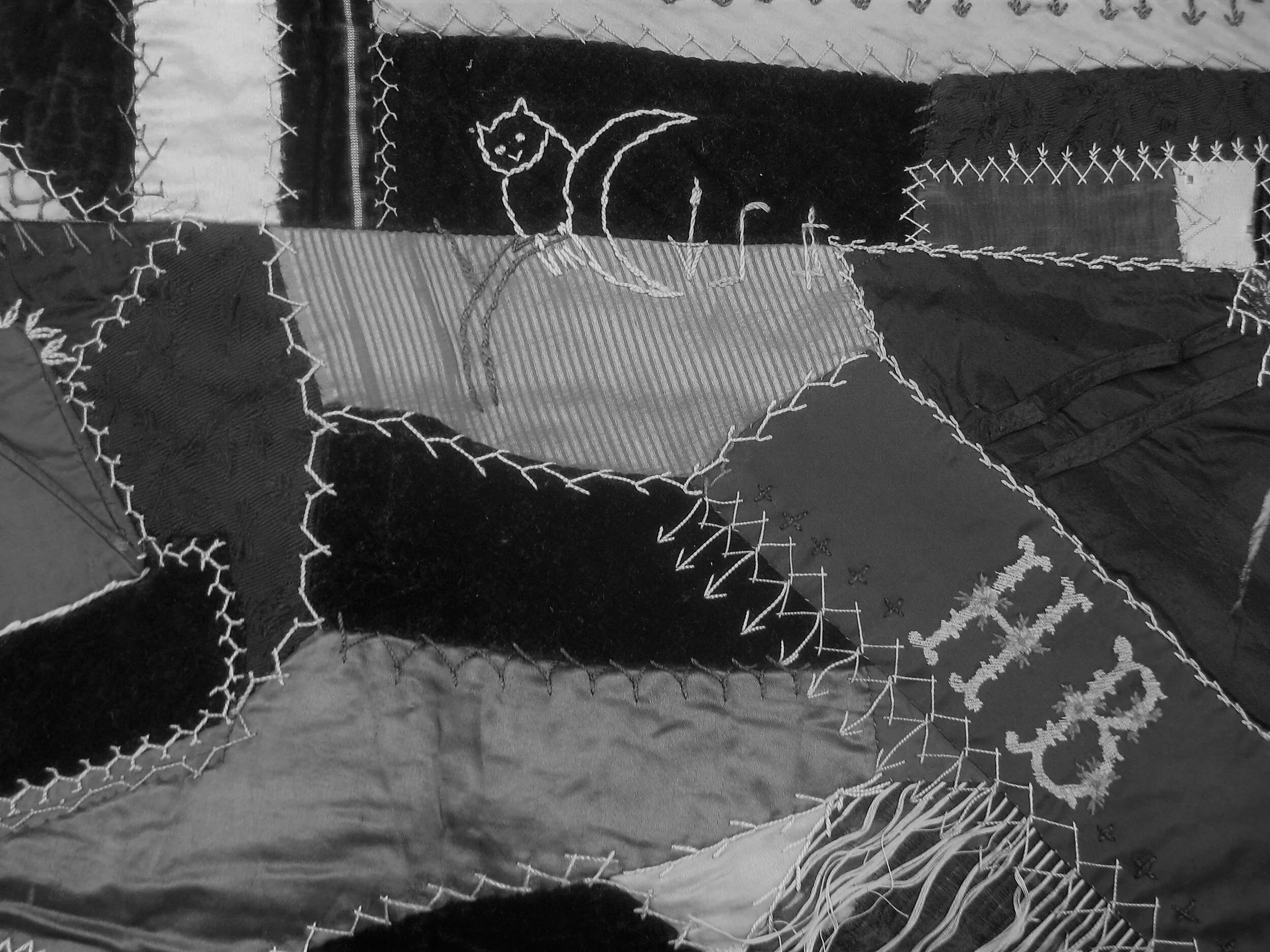Eastside Stories
Eastside Stories is our way of sharing Eastside history through the many events, people places and interesting bits of information that we collect at the Eastside Heritage Center. We hope you enjoy these stories and share them with friends and family.
Article by Angeline Nesbit
Within the Eastside Heritage Center’s collection there are many quilts. These quilts come in different patterns which utilize small pieces of cloth to create designs, tell stories, and create a testimonial to the skills of their creators. One truly unique type of patchwork is seen in a style known as “crazy quilting”, the quilt we will discuss today exhibits this style perfectly and was made by Rosanna Miller Shiach in 1886.
When you look at the quilt features in this article it may seem obvious that the name “crazy quilt” refers to the odd-shapes, overly embellished, and sometimes chaotic style of the crazy quilt, but the name actually has more meaning than this. Crazy quilt style is believed to have been inspired by the American’s World Fair in Philadelphia, held in 1876. At the fair, Japanese art of many different styles was featured including a type of pottery glaze known as “crazing” which gave the glaze a fractured look. This style became increasingly popular over the next few years alongside the development of the uniquely Victorian aesthetic of overly embellished organized clutter.
photo (above): this photo shows about one half of the crazy quilt which Rosanna Miller Shiach created between 1886 and 1889.
Originally a type of design only accessible by wealthy women, manufacturers of textiles began to produce ready-made patterns and even cigarette and cigar companies caught onto the craze over time, including silk pieces for men to give to the women in their lives with every purchase. It seems that by 1886, crazy quilts had already reached California and Rosanna Miller Shiach. She started the piece in Petaluma, California where she worked as a schoolteacher and created one of the Eastside Heritage Center’s finest examples of the style. Some of the history of her life is recorded in this quilt.
In 1889 Rosanna married David James Shiach and moved to the eastside that same year, ending up in Kirkland where she and her husband are buried today. Bringing her needlework with her, the story of this quilt and her new life can be seen in the details of the piece. It took Rosanna ten years to complete and over that time she added letters, dates, and images. It is difficult to decipher today without Rosanna to explain some of the choices she made, but the embroidered elements have the potential to make this extremely decorative work both beautiful and a record of some of the things in Rosanna’s life.
Photo (above): This photo shows the recording of the beginning of this quilt as well as an applique star.
Although her granddaughter believed the quilt to have been started the year of Rosanna’s marriage in 1889, the embroidered year 1886 on this quilt indicates otherwise. Both the beginning year and the end month are recorded along with Rosanna’s name where she stitched “Mrs. D.J. Shiach Mar 1896”. Initials and acronyms including H.B., LEM., and R.M. are seen included although it is hard to definitively say who these letters represent. Still, the variety of fabric and the use of imagery gives us some idea of Rosanna’s life during the creation of this quilt. Rosanna’s daughter, Ethel Rose, was born during this time and they lived close to her husband’s brother William, his wife, and their six children.
This quilt has nine square panels, each one featuring intricate stitching, applique, and embroidery. They were created separately and then sewn together with a three-inch red flower border surrounding the quilt. Decorative images such as an owl alongside a crescent moon, birds, fruit, and stars show her skill with drawing while the complex embroidery stitches used to join sometimes delicate fabric only further display her skill with needlework.
Photo (above):This detail photo of Shiach's quilt shows some of the imagery and letters she included in her designs as well as the complex embroidery stitches used to hold the cloth together in this style of quilt making.
Images of nature seem appropriate when some more information is revealed about what kind of a life Rosanna moved to with her new husband. David had bought their home, a 160 acre homestead in 1888 and grew his own menagerie of animals among the well-stocked forests of the Pacific Northwest. They were reported to have been gifted two fawns from which David raised his own herd of deer. In 1918 the Lake Washington Reflector reported David to be raising “bareneck” chickens from Transylvania and many pets which included foxes, a mink, raccoons, and rabbits.
Since the development of textiles, women have played a large role in their production, creating both decorative and utilitarian objects. Through their handicraft’s women have made a record of their own lives through woven or sewn objects. Women like Rosanna Miller Shiach have recorded their personal story as well as the lives of others for thousands of years. Not only preserving some of her own experience, this crazy quilt’s aesthetic also shows the style of the time that Rosanna lived in as crazy quilts’ popularity has a distinct timeline. The Eastside Heritage Center is proud to keep preserving this quilt and many other textiles that represent the history of our region.
Resources
The Eastside Heritage Center Archives and Donor information
https://24blocks.com/quilting-history-american-crazy-quilts/
http://www.womenfolk.com/quilting_history/crazy.htm
https://www.allpeoplequilt.com/quilt-patterns/history-of-the-crazy-quilt






